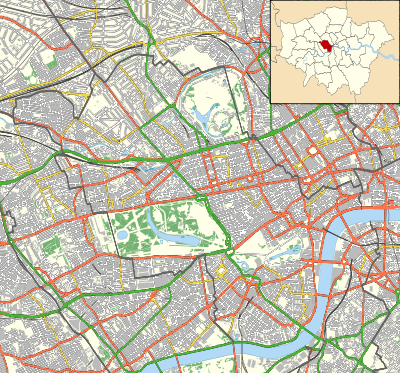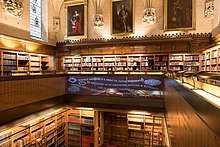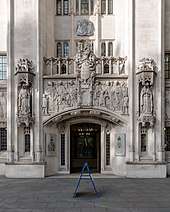Middlesex Guildhall
The Middlesex Guildhall is the home of the Supreme Court of the United Kingdom and of the Judicial Committee of the Privy Council. It stands on the south-west corner of Parliament Square in London. It is a Grade II* listed building.[1]
| Middlesex Guildhall | |
|---|---|
.jpg) | |
| Location | Parliament Square, London |
| Coordinates | 51°30′01.3″N 0°07′41.3″W |
| Built | 1913 |
| Architect | J. S. Gibson |
| Architectural style(s) | Art nouveau gothic |
Listed Building – Grade II* | |
| Designated | 5 February 1970 |
| Reference no. | 1226369 |
 Location of Middlesex Guildhall in City of Westminster  Middlesex Guildhall (Greater London) | |
History


The site on the south-west corner of Parliament Square was originally the belfry of Westminster Abbey. The first guildhall, designed as an octagon with a Doric portico by Samuel Pepys Cockerell, was completed for the justices of the City and Liberty of Westminster in 1805.[2] In 1889 Westminster became part of the County of London, outside of jurisdiction of the county of Middlesex. In the division of property between the Middlesex and London county councils, the guildhall at Westminster went to Middlesex in exchange for the Middlesex Sessions House in Clerkenwell. In addition to being a facility for dispensing justice, following the implementation of the Local Government Act 1888, which established county councils in every county, the guildhall also became the meeting place of Middlesex County Council.[3]
The second guildhall, designed by F. H. Pownall in the neo-Tudor style, was constructed on the site in 1893.[4][5]
The current and third guildhall, designed by J. S. Gibson in what Pevsner called an "art nouveau gothic" style, was built between 1912 and 1913. It has a doorway in the rear that dates from the seventeenth century. Originally part of the Tothill Fields Bridewell prison, the door was moved to this site to be incorporated in the building. The building is decorated with medieval-style gargoyles and other architectural sculptures by Henry Charles Fehr.[6]
Following the implementation of the London Government Act 1963, Middlesex County Council and the Middlesex sessions were abolished in 1965, but the guildhall continued to be used by the Greater London Quarter Sessions. After the abolition of the Quarter Sessions in 1972, it was used as a Crown Court.[7]
The Middlesex Guildhall was closed for refurbishment in 2007 to convert it for use as the site of the new Supreme Court of the United Kingdom and the Judicial Committee of the Privy Council. The Supreme Court, established in law by the Constitutional Reform Act 2005, started operations on 1 October 2009.[8]
Controversy over conversion
After the government chose the Middlesex Guildhall as home for the new Supreme Court, it was realised that a great deal of work was required to renovate the building and adapt it to the new use. Renovation plans were developed by architects Feilden+Mawson LLP, supported by Foster & Partners.[9]
Conservation groups were concerned that the planned conversion would be unsympathetic to such an important historic building. The Middlesex Guildhall is a Grade II* listed building, and the statement of importance by English Heritage classed the three main Court interiors as "unsurpassed by any other courtroom of the period in terms of the quality and completeness of their fittings" on 26 August 2004. The conversion works involved the removal of many of the original fixtures and fittings. Save Britain's Heritage unsuccessfully contested the conversion.[10][11]
See also
References
- Historic England. "Middlesex Guildhall (1226369)". National Heritage List for England. Retrieved 17 September 2009.
- "Sessions House". Sir John Soane's Museum. Retrieved 19 August 2019.
- "Local Government Act 1888". Legislation.gov.uk. Retrieved 17 August 2019.
- Robbins, Michael (1953). Middlesex. A New Survey of England. Collins.
- "1892 – Guildhall, Westminster, London". Archiseek. Retrieved 19 August 2019.
- "Architectural Sculpture at the Middlesex Guildhall". Victorian Web. Retrieved 19 August 2019.
- "A visit to Britain's newest and highest court – the Supreme Court". The Kensington Society. 9 May 2019. Retrieved 19 August 2019.
- "From House of Lords to Supreme Court". UK Parliament. 23 July 2009. Retrieved 19 August 2019.
- Department for Constitutional Affairs – Constitutional Reform
- "The Supreme Court and the Middlesex Guildhall – the real story". Save Britain's Heritage. Retrieved 27 May 2018.
- "Grand designs". BBC. 7 March 2007. Retrieved 19 August 2019.
Further reading
- The Supreme Court of the United Kingdom: History, Art, Architecture Chris Miele ed. (Merrell) ISBN 978-1-85894-508-8
External links
| Wikimedia Commons has media related to Middlesex Guildhall. |
- Middlesex Guildhall profile from the Supreme Court of the United Kingdom's official website
- In pictures: UK Supreme Court
